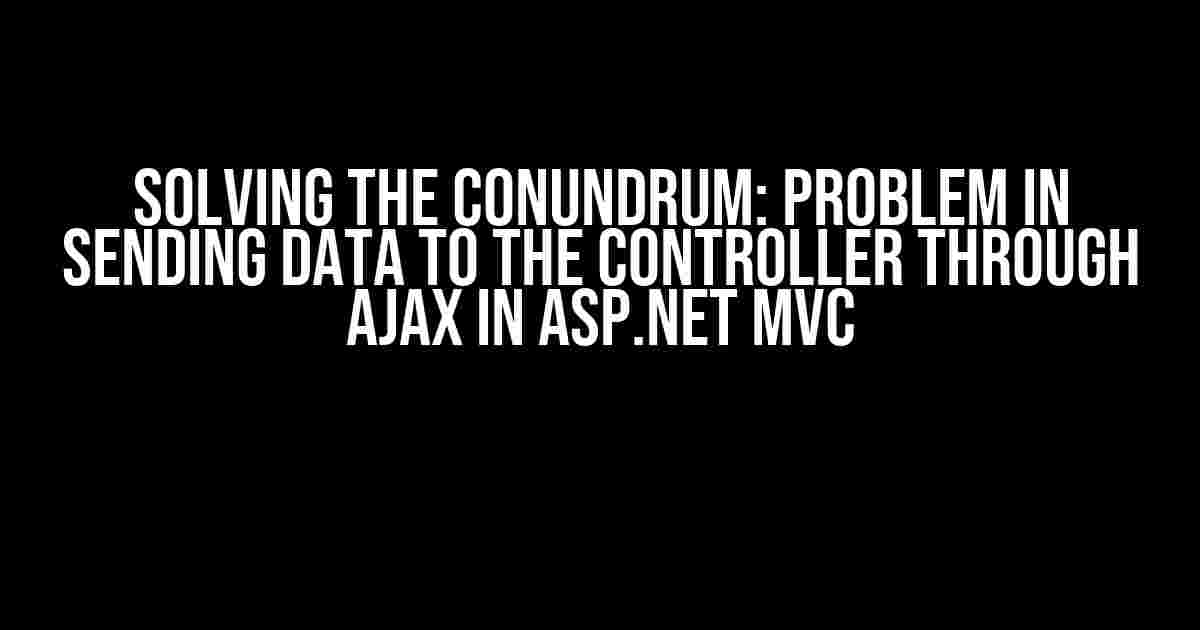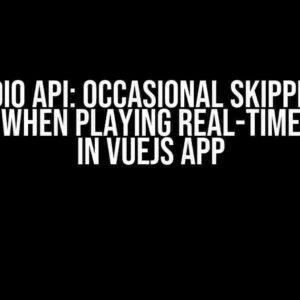Are you tired of wrestling with the pesky issue of sending data to your controller through Ajax in ASP.NET MVC? Fear not, dear developer! This comprehensive guide is here to save the day, providing you with clear, step-by-step instructions to overcome this common hurdle.
Understanding the Problem
When working with ASP.NET MVC, it’s not uncommon to encounter issues when sending data to the controller using Ajax. This problem can manifest in various ways, such as:
- Data not being received by the controller
- Controller action not being called
- Json serialization errors
- jquery.ajax() method not working as expected
Before we dive into the solutions, let’s take a step back and understand the underlying concepts.
Ajax in ASP.NET MVC: A Brief Overview
Ajax (Asynchronous JavaScript and XML) is a technique used to send and receive data from the server asynchronously, without requiring a full page reload. In ASP.NET MVC, Ajax is commonly used to send data to the controller using the jQuery.ajax() method.
$.ajax({
type: "POST",
url: "/Controller/Action",
data: { /* data to be sent */ },
success: function(result) { /* success callback */ },
error: function(xhr, status, error) { /* error callback */ }
});Common Causes of the Problem
Now that we have a basic understanding of Ajax in ASP.NET MVC, let’s explore the common causes of the problem:
- Incorrect controller action signature: The controller action method must match the HTTP verb used in the Ajax request (e.g., POST, GET, PUT, DELETE).
- Missing or incorrect data serialization: The data being sent must be serialized correctly, using a supported format such as JSON or XML.
- Invalid or missing routing configuration: The routing configuration must be set up correctly to map the Ajax request to the controller action.
- Javascript errors or conflicts: JavaScript errors or conflicts with other libraries may prevent the Ajax request from being sent or received correctly.
Solutions to the Problem
Now that we’ve identified the common causes of the problem, let’s explore the solutions:
Solution 1: Verify the Controller Action Signature
Ensure that the controller action method matches the HTTP verb used in the Ajax request:
[HttpPost]
public ActionResult MyAction(string data)
{
// process data
return Json(new { success = true });
}Solution 2: Serialize Data Correctly
Use a supported data format, such as JSON, to serialize the data being sent:
var data = { foo: 'bar', baz: 'qux' };
$.ajax({
type: "POST",
url: "/Controller/MyAction",
data: JSON.stringify(data),
contentType: "application/json; charset=utf-8",
success: function(result) { /* success callback */ },
error: function(xhr, status, error) { /* error callback */ }
});Solution 3: Configure Routing Correctly
Verify that the routing configuration is set up correctly to map the Ajax request to the controller action:
routes.MapRoute(
name: "Default",
template: "{controller}/{action}/{id}",
defaults: new { controller = "Home", action = "Index", id = UrlParameter.Optional }
);Solution 4: Debug and Test the Ajax Request
Use debugging tools, such as the browser’s developer console or a tool like Fiddler, to inspect the Ajax request and identify any errors or issues:
$.ajax({
// ...
error: function(xhr, status, error) {
console.log(xhr.responseText);
console.log(error);
}
});Solution 5: Use Ajax Global Events
Use Ajax global events, such as ajaxSend and ajaxComplete, to debug and inspect the Ajax request:
$(document).ajaxSend(function(event, xhr, options) {
console.log(options.url);
console.log(options.type);
});
$(document).ajaxComplete(function(event, xhr, options) {
console.log(xhr.responseText);
});Best Practices for Sending Data to the Controller through Ajax
To avoid common pitfalls and ensure successful data transmission, follow these best practices:
- Use JSON data format: JSON is the most widely supported and efficient data format for Ajax requests.
- Verify controller action signature: Ensure the controller action method matches the HTTP verb used in the Ajax request.
- Use routing correctly: Verify that the routing configuration is set up correctly to map the Ajax request to the controller action.
- Debug and test the Ajax request: Use debugging tools to inspect the Ajax request and identify any errors or issues.
- Handle errors and exceptions: Implement error handling and exception handling mechanisms to handle unexpected errors or issues.
Conclusion
Sending data to the controller through Ajax in ASP.NET MVC can be a challenging task, but by following the solutions and best practices outlined in this article, you’ll be well-equipped to overcome this common problem. Remember to verify the controller action signature, serialize data correctly, configure routing correctly, debug and test the Ajax request, and follow best practices to ensure successful data transmission.
By implementing these solutions and best practices, you’ll be able to send data to the controller through Ajax with confidence, and take your ASP.NET MVC application to the next level.
| Causes of the Problem | Solutions |
|---|---|
| Incorrect controller action signature | Verify controller action signature |
| Missing or incorrect data serialization | Serialize data correctly using JSON |
| Invalid or missing routing configuration | Configure routing correctly |
| Javascript errors or conflicts | Debug and test the Ajax request |
Don’t let the problem of sending data to the controller through Ajax in ASP.NET MVC hold you back. With this comprehensive guide, you’ll be equipped to overcome this common hurdle and take your ASP.NET MVC application to new heights.
Resources
For further reading and reference, check out the following resources:
With this article, you’re now well-equipped to tackle the problem of sending data to the controller through Ajax in ASP.NET MVC. Happy coding!
Here are 5 Questions and Answers about “Problem in sending data to the controller through Ajax in ASP.NET MVC”:
Frequently Asked Questions
Getting stuck while sending data to the controller through Ajax in ASP.NET MVC? Worry not! We’ve got you covered!
Why is my Ajax call not hitting the controller action?
This is often due to the fact that the URL of the Ajax call is not correctly formatted or the controller action is not decorated with the correct HTTP verb (e.g., [HttpPost] or [HttpGet]). Double-check your URL and make sure the controller action is correctly decorated.
How do I pass data from my view to the controller using Ajax?
You can pass data using the `data` property in the Ajax options. For example, `data: { id: 1, name: ‘John’ }`. This data will be sent to the controller action and can be accessed using the `Request` object or by creating a model to bind the data to.
What is the correct way to return data from the controller to the Ajax call?
You can return data from the controller using the `Json` method. For example, `return Json(data, JsonRequestBehavior.AllowGet);`. This will serialize the data into a JSON object that can be accessed in the Ajax success callback.
How do I handle errors in the Ajax call?
You can handle errors in the Ajax call by using the `error` property in the Ajax options. For example, `error: function (xhr, status, error) { console.log(error); }`. This will log the error to the console, but you can also display the error to the user or perform other actions as needed.
Can I use Ajax to upload files to the controller?
Yes, you can use Ajax to upload files to the controller, but it requires a bit more effort. You can use the `FormData` object to send the file and other data to the controller. For example, `var formData = new FormData(); formData.append(‘file’, file);`. Then, in the controller, you can access the file using the `Request` object.



